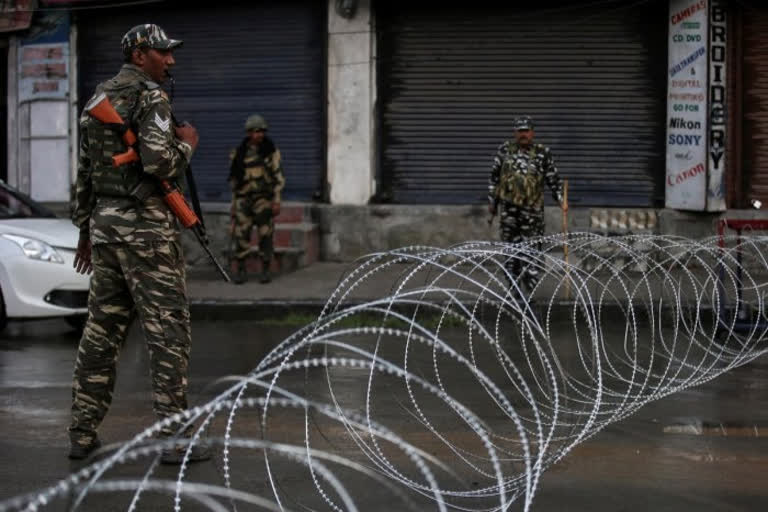New Delhi: On the eve of the holy month of Ramzan, a period of sacrifice and prayer that will begin in a day or two, there are ominous signals in the troubled Kashmir Valley.
Several seemingly unrelated recent developments may be a pointer to the intensity and extent of the Kashmir conflict this summer which is already pregnant with the promise of much bloodshed.
On April 13-14, a team of commandos from the National Directorate of Security (NDS) in Afghanistan stumbled upon a startling discovery. Upon attacking a suspected Taliban camp located in Momand dara in Nangarhar province bordering Pakistan and shooting dead 15 militants, they discovered that only five were Afghans, the other 10 were Jaish-e-Mohammad (JeM) militants from Pakistan and Pakistan-occupied Kashmir (PoK) being trained by the Taliban to fight in Kashmir. The confessions of a nabbed militant spilled the beans.
What deeply concerns the Indian security establishment is the direct involvement of the Taliban in training militants to carry out attacks in Kashmir.
According to media reports, training modules specifically tailored to meet requirements in Kashmir had been worked out. Structures within the Nangarhar training camp had been erected to resemble terrain and spots on the Line of Control (LoC) usually favoured by militants to cross over to India.
With the powerful about-60,000-strong Taliban being a state with a state in Afghanistan, their total and open support to the Kashmir militancy movement is a very serious issue fraught with far-reaching implications for the security situation in India.
There are also reports in the Afghanistan media about the flocking of thousands of non-Afghan militants belonging to the Islamic State (Daesh), Al Qaida and other groups trying to build a base in Dara-e Khustak area in Badakhshan’s Jurm district.
Traditionally a hotbed of insurgent activities, Badakhshan, in northeast Afghanistan is a very restive and sensitive province that shares long borders with Pakistan, Tajikistan, and China, that is not very far off from Pakistan-occupied Kashmir.
With the Taliban in a much stronger position in Afghanistan and given the close rapport between the Pakistani secret agency the ISI, Taliban’s domination in Afghanistan and in the Af-Pak border is akin to an extension of Islamabad’s writ. So Pakistan can afford not to worry much about its western frontier, leaving it free to focus primarily on its eastern frontier with India. That deep ISI focus can only be inimical to India’s interest.
Meanwhile, in the Kashmir Valley, there have been a string of grenade-throwing incidents since October especially targeting the state police and the paramilitary where a newly-formed outfit called The Resistance Front (TRF) has claimed responsibility for these attacks.
Significantly, on April 5, five TRF militants were killed in an encounter with a Special Forces squad, which took a hit of equal number of commandos in the snow-clad high altitude area of the Keran sector near the LoC. The encounter may be an indication of the specialist training the TRF men might be getting.
The TRF, which embarked on a social media offensive since its formation in October 2019, has tried to present itself as the indigenous face of the militancy movement, especially after the gradual fading away of the Hizbul Mujaheedin. The two other prominent outfits in the militancy movement are Jaish e Muhammad (JeM) and the Lashkar e Toiba (LeT), both having a dominant foreign element in their ranks.
Why the TRF may garner more appeal among Kashmiris is due to the fact that after the August 5, 2019 abrogation of Article 370, taking away statehood and division of the erstwhile Jammu and Kashmir state, there has been considerable angst among the people that has not found an outlet yet.
In such situations, it is the Over Ground Workers (OGW), essentially a network of sympathizers and active supporters of the militancy movement, who cross the Rubicon very easily. And the number of OGWs in Kashmir is significantly big.
Moreover, with the local leadership virtually being eased away, there is no immediate remedial platform for the people to vent their grievances. Outfits like TRF will try to exploit that angst.
Incidentally, this will be the first summer after the abrogation of Article 370.
Additionally, with the coronavirus pandemic occupying centre-stage and the active involvement of the Indian army and other security forces personnel in the effort, the focal attention on militants and their activity is bound to suffer. This is a situation that the militant forces, egged on by Pakistan’s stubborn deep state, will try their utmost to exploit.
On the other hand, the Indian state has largely had its way in Kashmir. Any setback would be considered nothing short of a failure as there would be no ground for excuses.
The security establishment will therefore hold nothing back to dismantle the militancy movement and root out its infrastructure in a no-holds-barred offensive. Sadly, for now, the ‘battle for the hearts and minds’ may get relegated to the backburner.
As of now, a few trends are already visible that should worry the administration much. There has remarkably been no active response to the process of delimitation of the electoral constituencies, neither to changes in domicile laws. Civic society has been muted in its response. What would add to the concern, on the other hand, is the recent increase in the number of encounters.
In sum, the situation presents a perfect recipe for a violent showdown.



